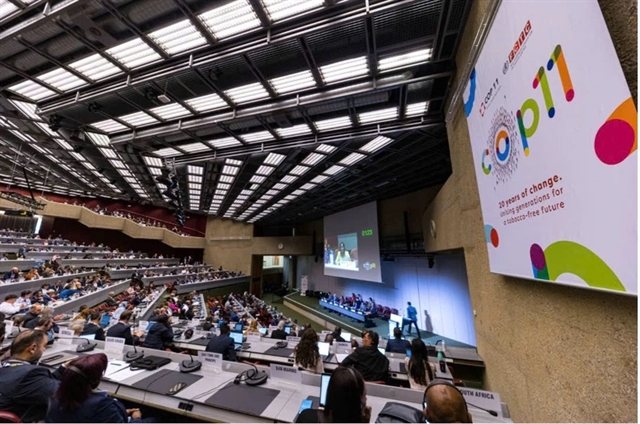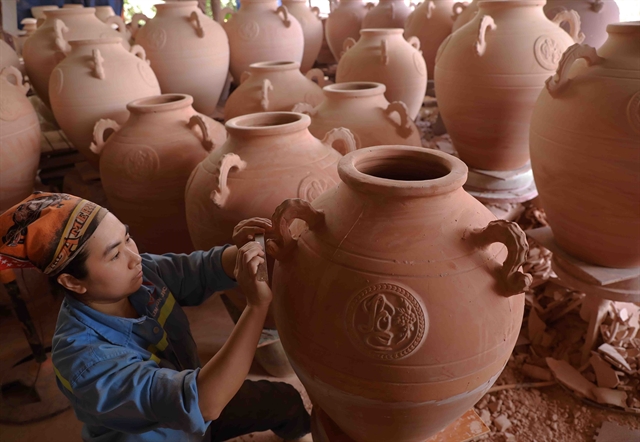 Society
Society

 |
| A farmer works at a traditional handicraft village in Quảng Ninh Province. — VNA/VNS Photo Vũ Sinh |
HÀ NỘI — The average income of people doing rural occupations will be 2.5-3 times higher than in 2020.
It is one of the main targets of the rural careers development strategy until 2030, with a vision to 2045, which has been approved by Deputy Prime Minister Trần Lưu Quang.
The strategy’s general goal is to develop rural careers, promote the potential of rural areas, improve production and business efficiency, increase income, create jobs and raise the material life of the people.
It aims at protecting the environment, preserving the landscape, enhancing traditions and national cultural identity.
The strategy will push up rural economic development towards ecological agriculture, modern rural areas and farmers.
It strives that the growth rate of rural occupations will be about 6-7 per cent per year by 2030.
Enterprises can attract about five million regular workers in rural occupations.
The export value of rural products will reach over US$6 billion per year.
The rate of trained workers will be 80 per cent and the rate of being awarded degrees and certificates is 35 per cent.
Localities will form stable raw material areas to meet 70 per cent of the rural industry development’s requirement.
It’s expected that by 2045, rural occupations will contribute to the overall growth of the national economy, develop rural industries in the direction of sustainable, smart, and environmentally friendly growth.
All will be associated with building green, clean, and beautiful rural spaces; preserving and intensifying the cultural, historical and traditional values of the region.
Orientation
The strategy provides development orientation for different groups including the group of processing and preserving agricultural, forestry and fishery products; handicraft production group; the group for handling and processing raw materials to serve rural production; the group for producing wooden furniture, rattan, ceramics, glass, textiles, yarn, embroidery, wicker and small mechanics; group for producing and trading ornamental animals; salt production group; and group for services.
For groups of processing and preserving agricultural, forestry and fishery products, the strategy will increase the use of machinery and equipment, and apply technical advances and modern, environmentally friendly technology to production.
It will improve chain production processes, ensure nutrition and food hygiene and safety, enhance product quality to increase competitiveness, expand product consumption markets for export.
Regarding handicraft production group, the strategy targets to create new designs to suit demand of domestic and foreign consumers.
It will strengthen links between handicraft villages, and combine raw materials regions to create new, unique, artistic and highly usable products.
For groups of handling and processing raw materials for rural production, it is planned to improve processing facilities to create new raw materials, especially recycled materials, to replace imported ones.
Preserve craft villages
The orientation of preserving and developing craft villages is to focus on the ones that are at risk of disappearing.
It will be close to tourism growth, building distribution channels and introducing craft village products.
Professional associations and unions, innovation centres, businesses, and vocational training centres will be founded in localities.
Regarding the domestic consumption market, the strategy will connect products with large cities, diversify services to meet increasing demand, and set up rural tourism and craft village tourism programmes.
For the export market, it will increase products into common markets such as China, the US, Europe, Japan, Korea; and expand into new potential markets in the Middle East, Latin America and Africa.
Competent agencies will urgently relocate polluting production facilities in residential areas to industrial zones and concentrated production zones.
They will preserve rural landscapes together with eco-smart villages, ensuring green, clean, beautiful and environmentally friendly landscapes.
Also under the strategy, related organisations will effectively deploy programmes to build new-style rural areas; diversify and push up the quality of tourism products; and promote traditional rural cultural values. — VNS




